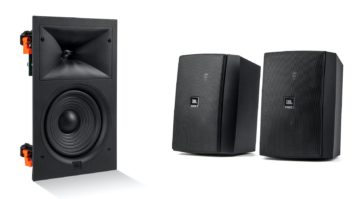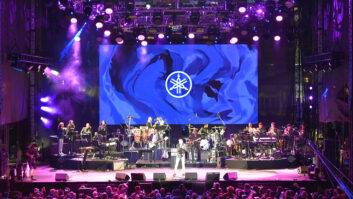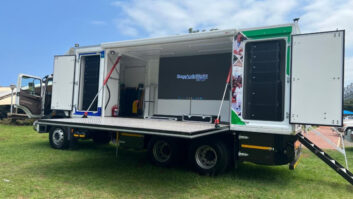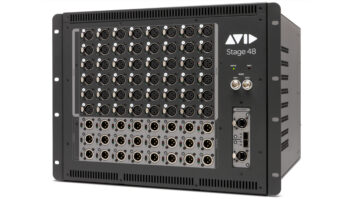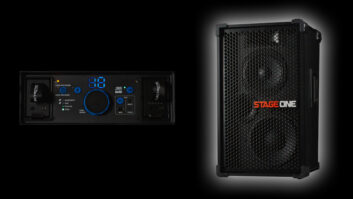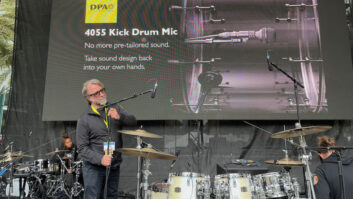
With a heritage that includes the groundbreaking Cantus and Cinetra
digital mixing consoles, in 10 short years, Stage Tec has significantly
influenced both the inward and outward design of digital desks. The
company’s impressive client list — including ABC-TV in Los
Angeles, 20th Century Fox, Skywalker Ranch, Warner Bros. Films and a
host of similar European and worldwide users — bears ample
testimony to this fact.
When I heard that Stage Tec had a
brand-new console that needed to be scrutinized in Berlin, I jumped at
the opportunity to be among the first to see what it had come up with
this time. I wasn’t disappointed.

BRAINS AND BEAUTY
The Aurus console is an extremely lightweight, yet large-framed
console specifically designed for work in film, television or live
sound mixing. It is the most sleek, 21st-century-looking digital audio
console yet designed, and requires more than a second glance to confirm
that the slim-line, ultrathin chassis can easily be lifted and
transported by two people.
This wonderful, slim design is made possible by the use of the Nexus
Star digital audio routing and interconnecting system found in Stage
Tec’s Cantus console. Nexus Star is the superfast “brain”
of the Aurus, having all of the DSP cards located in a 19-inch rack.
This can be located right next to the console or in a remote position
as your needs require. (Even distances of up to 45 miles away can be
accommodated.)
Where Nexus scores big over many other exterior rack-based network
systems is that it doesn’t need specialized cool-room environments or
large, cumbersome multicore interconnectivity with the console. There
isn’t a fan to be found anywhere in the entire system (except inside
the external computer running Linux Server, which is required only for
storage). This means that the whole Aurus setup runs cool and
quiet.
All communication between Nexus and Aurus is passed up and down the
dual fiber-optical connector from the rack to the desk; there’s no
multicore, just the one optical conduit to connect. Upward of 1
Gbit/sec of information can be transferred between the desk and rack,
which means that each and every parameter of the control surface can be
rewritten in as little as 10 ms.
Housing all of the 24-bit routing capacity that you’re ever likely
to require, the Nexus Star audio router/network can carry up to 16
boards, each with 256 inputs and outputs. If you do the math, this adds
up to a possible 4,096 input and 4,096 output sources at 48 kHz. The
Star router and the Aurus console may also work at 96 kHz. The AES/EBU
I/Os support sampling frequencies of 32 kHz up to 192 kHz. Included
into this network is the console’s DSP power, offering 40-bit,
floating-point signal processing. By any standards, that is a huge
amount of information to transfer around, but it’s also the key to the
success of the Aurus design. Everything that the control surface
requires in terms of DSP functionality is controlled through the fiber
conduit, hence the ability to design the console in a slim, lightweight
form.

INTUITIVE DESIGN
Because all of the DSP functionality is carried out only on the
Nexus Star, it’s possible to open the fader modules on the desk during
use and unplug an entire bay without the need to switch off or even
halt the mix. You can even maintain this console without switching it
off! When you do power-down, a hard reboot only takes 19 seconds, and
then you’re up and running again with your audio mix playing. In fact,
the slowest element in the entire process is rebooting the external
computer; used to store all the mixing data, it takes 37 seconds to
boot.
Visually, Aurus is pleasing to look at. I hesitate to describe it
“uncomplicated,” as the desk is complex in functionality.
It has a striking simplicity that reminds me of the days when exploring
new pieces of equipment was fun and something to look forward to. It
took me only minutes to find my way around the desk; in a matter of an
hour or so, I had it completely figured out.
Constructed to look much like an analog inline desk, the Aurus
control surface has seven 15-inch color TFT flat screens, all
configurable to user needs. A dedicated master control section, with a
familiar Windows XP GUI, displays the matrix, routing and detailed
parameter functions. It also serves as an interface for save and recall
functions. Each channel strip has 100mm touch-sensitive moving faders
with full automation capabilities. These modules come in groups of
eight faders, and can be removed and placed anywhere within the frame
of the control surface to suit the user’s specific requirements.
The channel strips have 11 double-concentric, dual-function rotary
encoders; they are touch-sensitive and control everything from input
gain to dynamics parameters. Information is displayed on fan LEDs above
the encoders or a series of alphanumeric character lines lower down.
Like most modern consoles, these encoders are multifunctional and
layered; thankfully, due to the sheer quantity of them, the number of
these layers has been kept to a minimum. The top four encoders are
primarily auxiliaries and the lower five are primarily for assigning
dynamics parameters.
Up to 96 assignable channel strips and 300 audio channels (256
buses) are possible depending upon your configuration. Through this
design compromise, all of the vital parameters and their indicators are
accessible; the designers wisely chose not to clutter the surface with
unnecessary function that might detract from performing the job.
Each channel parameter can be tweaked to detailed perfection in the
master control section. And this is where the true mastery of the
Nexus/optical connection is displayed: A graphic indication of the
signal path is shown on the main display screen with each of the
modules, I/O, pan, EQ, compressor, fader, etc., designated as a block.
Nothing new there, you might say, and you’d be right. But because of
the sheer speed of the information throughput, each block can be picked
up in real time and moved anywhere in the signal path. For instance,
you can place the fader before the insert point, place the mute before
the compressor, and so on, and you instantly hear the result of your
endeavors.
Virtually any setup can be created, though the signal flow is
governed by some basic principles. Signal sources are fed into the
respective Nexus boards. These are then routed to the mixing console
channels via the input matrix, and then the console performs the
parameter processing similarly to an analog console, with the signal
routed to different buses or direct outputs. These bus signals can then
be edited into various configurations before being fed back into the
Nexus audio network via the output matrix.
What’s more, you can save these configurations as you build them to
the external computer that’s used to drive the graphics on the display.
This gives you virtually unlimited storage and recall of setups for mix
situations or different working environments. Configurations can be
saved or recalled differently for each channel strip, and then copied
and pasted elsewhere within the console layout, building up a project
as you go; it’s that quick. You can even alter the signal path in real
time using this method to A/B a channel or a group of channels, and
hear the resulting effect.
FLEXIBLE MULTICHANNEL CAPABILITY
But there’s more. All of the parameters of each channel strip are
displayed either on the TFT screen immediately above the bay where the
channel is situated or in detail in the central “master”
section TFT display. Each display can then be totally customized to the
user’s methods of working, showing the name, filter settings, dynamics
units or routing information if desired. A quick overview guide of the
parameter settings are displayed in each channel; more detailed
information can be obtained by selecting a channel and then viewing the
enhanced detail in the main section display.
Naturally, Aurus is a true multichannel processing console, with
multiple independent monitor paths supporting a wide variety of
formats. This even includes three insert points for external cinema
processors, as well as solo and mute functions for individual
monitoring paths that are directly accessible via dedicated buttons.
The solo bus is multichannel-enabled, allowing routing of up to eight
monitor signals to the bus. Surround parameters can be accessed using a
variety of controllers from the obligatory joystick, a discrete keypad
(hidden below the armrest), jog wheel, tablet and pen.
CONCLUSION
The Aurus Fibre-channel network even allows for multiple monitor
setups to be configured directly from the console itself’ — no
more cumbersome and ugly spaghetti-like masses hanging from the back of
the console. Simply plug your monitors — near, mid or room
— straight into the Fibre-channel system, and the monitoring
buses take over from there. The master section allows user monitor
setups to be programmed using several preprogrammed standard options,
as well.
The Aurus is a truly adaptable digital audio console with just about
every variable necessary (and, more importantly, includes those that
are required). It is constructed around a simple user interface and
control surface, with a lightweight, beautifully designed
framework.
While it can be considered inherently dangerous to attempt to create
a device that has the potential of matching all of the needs of so many
different users, the Aurus really does seem to match up to Stage Tec’s
assertions. Stage Tec should be applauded not only for listening to
end-users, but for also having the courage to build the product
afterward. A lot of people will be genuinely surprised at this desk
when they give it a closer look. Aurus is not only pleasing on the eye,
but it gets the job done with minimum fuss, regardless of your needs or
your work environment. And you don’t come across that everyday.
Stage Tec, www.stagetec.com.

three views of the Stagetec Aurus



Robert Alexander is the former executive editor of
Audio
Media
, a musician, audio engineer, writer, journalist and
globe-hopping bon vivant
.

